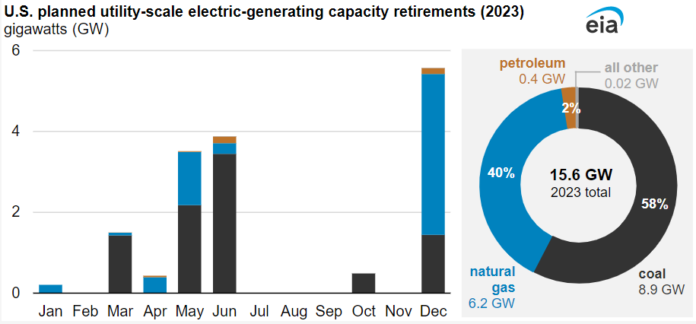
Gas power plant. Image by nachai on 123rf
According to the Department of Energy’s Energy Information Administration (EIA), US operators plan to retire 15.6GW of electric-generating capacity in 2023, mostly natural gas-fired (6.2GW) and coal-fired (8.9GW) power plants.
EIA said that substantial US coal-fired capacity has retired over the past decade, and a record 14.9GW was retired in 2015.
Annual coal retirements averaged 11GW a year from 2015 to 2020, fell to 5.6GW in 2021, and then rose to 11.5GW in 2022.
Data source: EIA, Preliminary Monthly Electric Generator Inventory, December 2022

In 2023, power plant owners and operators plan to retire 8.9GW of coal-fired capacity, around 4.5% of the total coal-fired capacity at the start of the year.
Most coal-fired power plants currently operating were built in the 1970s and 1980s. As these plants compete with a growing number of natural gas-fired plants and low-cost renewables, more coal-fired units are being retired.
EIA said the largest coal-fired power plant expected to retire this year is the 1,490MW W.H. Sammis Power Plant in Ohio. The oldest four of the plant’s seven coal-fired units were retired in 2020; the last three units are slated to shut down this year, along with the plant’s five petroleum-fired units (13MW of combined capacity).
Pleasants Power Station (1,278MW) is the second-largest coal-fired power plant retirement expected this year. Energy Harbor, which plans to become a carbon-free electricity supplier by the end of this year, owns both W.H. Sammis and Pleasants.
In addition, some 6.2GW of natural gas-fired capacity is slated to retire, roughly 1.3% of the operating natural gas fleet as of January. Most of that retiring capacity is made up of older steam and combustion turbine units.
Three aging natural gas-fired plants in California (Alamitos, Huntington Beach, and Redondo Beach), with a combined 2.2GW of capacity, are scheduled to retire. These plants were originally slated to retire in 2020 but were granted a three-year extension to maintain grid reliability.
Petroleum-fired power plants make up a small portion of generating capacity at around 2.2%. Most of these plants are seldom run and serve as peaker plants. This year, around 0.4GW of petroleum-fired capacity is scheduled to retire.